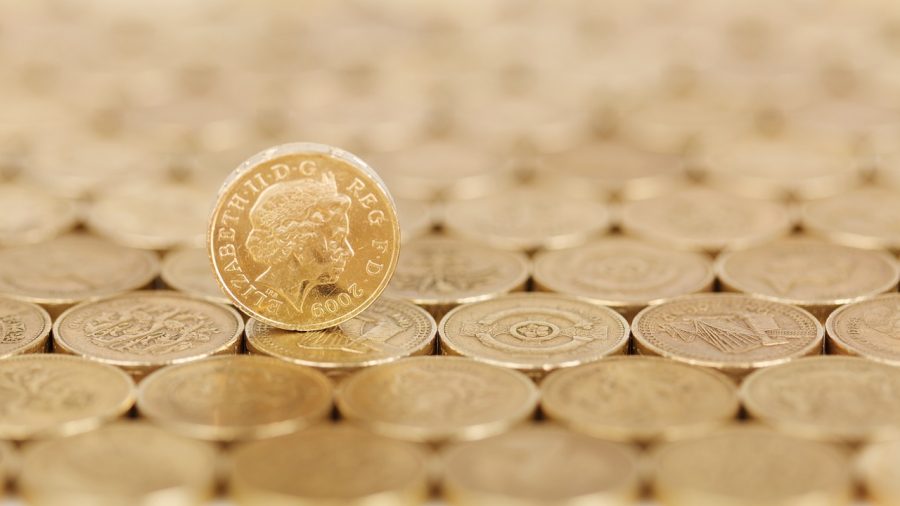
Pound Sterling eased after UK inflation slowed in October
The Pound Sterling eased on Wednesday after data showed British inflation cooled at its fastest pace in more than 30 years in October.

Reuters: The Pound Sterling eased on Wednesday after data showed British inflation cooled at its fastest pace in more than 30 years in October, reinforcing expectations that the Bank of England will be cutting interest rates by the middle of next year.
JOB MARKET: Freelancing: should you do it?
BRITISH POUND STERLING EASED
The British consumer price index rose by 4.6% in the 12 months to October, from September’s 6.7% increase, according to the Office for National Statistics. It was the lowest reading in two years and below forecasts for a reading of 4.8%. The drop to 4.6% from 6.7% was also the largest decline in the annual rate since April 1992. Sterling was last down 0.3% on the day at $1.2463 by 1135 GMT, compared with $1.2487 shortly before the data. The euro was up 0.1% against the pound at 87.13 pence.
Core inflation, which strips out food and energy prices, also rose less than expected, up 5.7% compared with 6.1% in September, and below estimates for a reading of 5.8%. “This is a large fall in the headline CPI, but was widely anticipated due to year-on-year effects and falling energy prices; nevertheless, it is good news which confirms the downward trend in inflation,” Richard Garland, chief investment strategist at Omnis Investments, said in a note. “It is likely to mean that the bank is in a good position to begin cutting rates in late 2024, but much depends on the strength of the labour market and the economy,” he added.
ALSO READ: Mo’s Crib breaks into the US décor market: AGOA
Inflation has been on a downward path since last October’s four-decade high of 11%, but it has proven more stubborn in Britain than elsewhere and is still well above the BoE’s target rate of 2%. CMC Markets strategist Michael Hewson said UK inflation has remained higher than that elsewhere in part because of how household energy bills were calculated and priced. Consumer electricity prices alone are still 40% above where they were two years ago, according to ONS data. “Inflation is artificially high relative to Europe and the U.S., but I think you can argue that’s a consequence of the fact that we are very much a services-driven economy and wage growth is much higher,” he added.
The government of Prime Minister Rishi Sunak pledged this year to halve inflation by the end of 2023, without specifying an outright level. “Now we are beginning to win the battle against inflation we can move to the next part of our economic plan, which is the long-term growth of the British economy,” British finance minister Jeremy Hunt said. The pound, meanwhile, hit a two-month high the previous day, when it staged its largest one-day rise against the dollar in a year, following U.S. data that showed the smallest annual increase in underlying consumer inflation in two years.
The figures reinforced the view that the U.S. Federal Reserve has probably also finished raising interest rates. Money markets show traders believe there is a good chance the BoE could start cutting rates by May next year. But BoE chief economist Huw Pill said on Tuesday that the expected fall in inflation to just under 5% would still leave it “much too high” even if it represented a more than halving in price growth over the past year. The BoE has sought to stress that it is nowhere near cutting interest rates from their 15-year high, even as the economy flat-lines close to a recession.
ALSO READ: ‘Good’ news for South Africa interest rates expected next week
SOUTH AFRICAN RAND
Reuters: The South African rand weakened against a stronger U.S. dollar on Wednesday despite better-than-expected local retail sales data. At 1512 GMT, the rand traded at 18.2400 against the dollar, 0.14% weaker than its previous close. The dollar was uparound 0.3% against a basket of major currencies. It gained after U.S. retail sales fell less than expected in October, bouncing off its biggest drop in a year the previous day. Like other risk-sensitive currencies, the rand often takes its cues from global drivers such as U.S. monetary policy.
Locally, Statistics South Africa data showed a 0.9% increase in year-on-year retail sales in September. Analysts polled by Reuters had expected a 0.1% rise. Investec analyst Lara Hodes said in a research note that consumers remained constrained despite September’s modest lift. “While fuel price cuts in November and likely December should offer consumers some reprieve, interest rates are likely to remain elevated for longer, weighing on the indebted,” Hodes said. On the Johannesburg Stock Exchange the blue-chip Top-40 and the broader all-share index ended the day around 2% higher. South Africa’s benchmark 2030 government bond was stronger in late deals, with the yield down 3 basis points to 10.205%.
ALSO READ: Fuel price: Mid-month diesel and petrol news GREAT for December 2023
U.S. DOLLAR
Reuters: The dollar held its ground early on Thursday after a volatile two days that saw sharp declines followed by a rebound as traders took incoming economic data as signalling the Federal Reserve will wait longer before cutting interest rates. The risk-sensitive Australian and New Zealand dollars sank amid a decline in regional equities. The U.S. currency was little changed at $1.08425 per euro and slipped 0.15% to 151.15 yen after mounting a recovery on Wednesday from its steepest declines against major peers in a year.
The dollar index – which measures the greenback against the euro, yen and four other rivals – added 0.11% to 104.43. It gained 0.31% on Wednesday, following a 1.51% plunge the previous day. The dollar drew support from better-than-expected retail sales numbers combined with more signs of a cooling of inflation, feeding into the narrative for an economic ‘soft landing’, which would allow the Fed more time before cutting rates. Traders trimmed the odds for a first reduction by March to less than 1-in-4 from better than 1-in-3 a day earlier, according to the CME Group’s FedWatch Tool.
“While inflation is falling, the economy remains robust, which might even allow the Fed to increase rates if they chose,” although there doesn’t seem to be appetite for a hike among Fed officials currently, said James Kniveton, senior corporate FX dealer at Convera. Elsewhere, the Aussie slid 0.29% to $0.64905, and the New Zealand dollar declined 0.5% to $0.5993. Australia’s currency failed to draw support from a strong rebound in employment, as traders keyed on the fact that gains were mostly in part-time labour, while the jobless rate actually ticked higher.
ALSO READ: Who is the richest person in the world today? Top 10 list – 16 November 2023
GLOBAL MARKETS
Reuters: Asian stock markets struggled for momentum on Thursday, after heavy gains this week, as expectations for a pause in Fed policy tightening remained intact despite U.S. data pointing to strength in parts of the economy. U.S. economic data this week has left investors in the same state of confusion about Fed policy as they have been in for weeks. Retail sales proved strong while producer prices inflation, coming soon after the below-forecast core inflation, reinforced the disinflation theme and supported views of a peak in U.S. rates.
“With inflation, labour market and retail sales data now published for this month, and expectations for an FOMC hike in December and January priced at zero, a huge amount of information has been digested by markets in a very short time,” analysts at ANZ said in a note. “A period of consolidation seems warranted, especially if Fed officials push back against the recent easing in financial conditions.” Early in the Asian trading day, MSCI’s broadest index of Asia-Pacific shares outside Japan was down 0.2%. The index is up 7.1% so far this month.
Australian shares were down 0.33%, while Japan’s Nikkei stock index slid 0.36%. The MSCI Asia ex-Japan index, MSCI Emerging Market index and Nikkei all posted their biggest gains in a year, of 2.5% or more, on Wednesday. Chinese industrial and retail numbers calmed nerves and lifted mainland stocks on Wednesday, with both data beating expectations in October even as the underlying economic picture highlighted significant pockets of weakness with the crisis-hit property sector continuing to forestall a full-blown revival.
ALSO READ: Newspaper front pages from around the world, 16 November 2023
China’s blue-chip CSI300 index was 0.1% lower in early trade. Hong Kong’s Hang Seng index dropped 0.35%. While markets didn’t react specifically to the news, investors also heard from the first meeting in a year between U.S. President Joe Biden and Chinese leader Xi Jinping on Wednesday, that the two leaders had agreed to resume military-to-military communications and cooperate on anti-drug policies. On Wednesday, U.S. stocks closed slightly higher, as the inflation data reinforced investor hopes the Fed is done raising interest rates, while retail stocks were boosted by an upbeat forecast from Target.
The Dow Jones Industrial Average rose 0.47%, the S&P 500 gained 0.16% and the Nasdaq Composite narrowed earlier gains to end flat. Money market traders have fully priced in the odds that the U.S. central bank will keep rates steady in December, as per CME Group’s Fedwatch tool. They also see the first rate cut of the cycle to kick off in May 2024. Investors are increasingly pricing in more rate cuts next year with bond yields and the dollar coming under downward pressure. Some of that reversed on Wednesday, with Treasury yields and the dollar rebounding slightly from the previous session’s fall.
The yield on benchmark 10-year Treasury notes was at 4.5117% compared with its U.S. close of 4.537% on Wednesday. The two-year yield, which rises with traders’ expectations of higher Fed fund rates, touched 4.8991% compared with a U.S. close of 4.916%. In currencies, the European single currency was up 0.1% on the day at $1.0852, having gained 2.61% in a month, while the dollar index, which tracks the greenback against a basket of currencies of other major trading partners, was up at 104.33. U.S. crude dipped 0.55% to $76.24 a barrel. Brent crude fell to $80.75 per barrel. Gold was slightly lower. Spot gold was traded at $1958.49 per ounce.
ALSO READ: IEC unveils historic 2024 elections program
